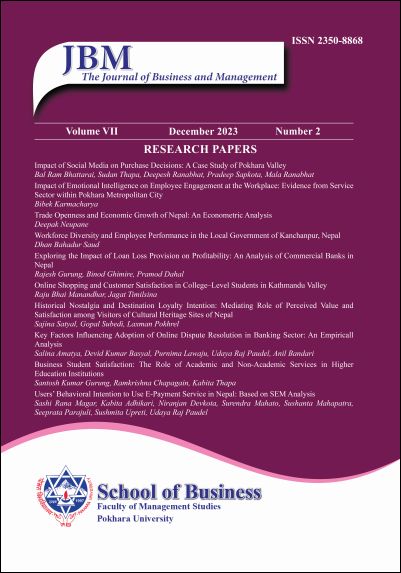Exploring the Impact of Loan Loss Provision on Profitability: An Analysis of Commercial Banks in Nepal
DOI:
https://doi.org/10.3126/jbm.v7i02.62587Keywords:
Capital adequacy ratio, loans and advances to deposit, non-performing assets, return on assetsAbstract
Background: The central bank closely examines the loan loss provision maintained by Nepalese commercial banks in order to minimize potential losses resulting from a rise in non-performing loans, which reduces bank capital and squeezes the profitability and sustainability of banks. Establishing the relationship between loan loss provision and profitability is crucial in assessing the financial performance and risk management effectiveness of commercial banks. This analysis enables banks to minimize loan loss provisions, reinforcing profitability and ensuring long-term sustainability through the implementation of appropriate credit policies.
Objectives: This research aims to analyses the influence of loan loss provision on the profitability of commercial banks in Nepal. The study also takes into account pertinent variables: non-performing assets, loans and advances to total deposits, and capital adequacy which may affect the relationship.
Methods: This study has used both the descriptive and causal-comparative study approaches. The study used a panel data set consisting of 105-year observations, spanning from fiscal year 2017/18 to 2021/22, including 21 presently active commercial banks.The return on assets (ROA) is the dependent variable and loan loss provision (LLP) is an independent variable. The Fixed Effect (FE) panel regression has been chosen as an appropriate model as suggested by the Haussmann test.
Results: A panel regression model has found a negative and substantial connection between the provisions for loan losses with the Nepalese commercial banks’ profitability.
Conclusion: The study concluded that the increased provision for loan losses adversely affects the profitability of commercial banks in Nepal. Therefore, commercial banks should carefully evaluate their loan portfolios, carry out thorough credit risk assessments, and adopt sensible policies to maximize profit and ensure financial stability.
Downloads
Downloads
Published
How to Cite
Issue
Section
License
Copyright © the School of Business. All rights reserved. No part of this volume may be reproduced or utilized in any form or by any means, electronic or mechanical, including photocopying, recording, or by and information storage and retrieval system, without permission in writing from the publisher.




